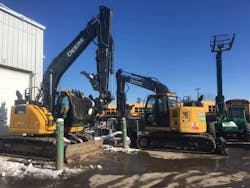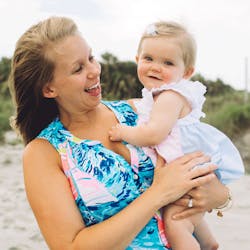Katy Lovering did not come to Sunbelt Rentals from a construction background, exactly. Her forte was the educational area of change management, honed at big box retailer Lowe’s thanks to exposure to a change-management firm called Conner Partners.
“Change impacts people, and you can’t institute or enact successful change without being very cognizant of the people who will be going through, or affected by, that change,” Lovering says.
Another in a series of profiles highlighting winners of the Under 40 in Construction Equipment Awards. If you know of or are a young leaders, nominations are open.
“It’s really about focusing on people first,” she says. “Focusing on their feelings, which is not always an easy thing, especially when you’re making business decisions.”
As senior director, strategic initiatives, with Sunbelt, Lovering’s job has entailed implementing major changes to the company’s business.
One of Lovering’s success stories so far is a program that empowers employees at every level to take direct action to service customers. It started with research.
Two years ago, Lovering and others within Sunbelt went out to the field to investigate the customer experience.
“We did some voice-of-customer research, and we were able to do some really cool stuff like customer focus groups in different markets,” Lovering says. “And we took that body of material—all this research, all this very direct customer feedback—and looked very critically at the service level that Sunbelt provides to our customers. Based on that feedback, we collectively said we can do better.
“We thought there were areas of opportunity that were pretty obvious from the feedback,” Lovering says. “We decided we would focus on packaging this as an opportunity for our employees to feel really, really empowered to do whatever they need to do to take care of our customers at any moment in time. What this ultimately ended up becoming is the Sunbelt Promise.”
The Sunbelt Promise is three concise tenets, availability, reliability, and ease, explained in five simple sentences: “We promise to have our core equipment available in the market you are in, or we will leverage our network to source it. We will deliver your equipment within one hour of our promised delivery time. While our equipment is on rent, we will be on site within one hour of our promised service time. We provide 24/7 customer support. We promise total customer satisfaction, in-person, online, and by phone.”
These would be bold promises if they were passed down to employees like cold corporate edicts from an ivory tower, but that’s not the way Lovering handles initiatives.
Sunbelt Rentals has around 900 branches in the U.S. and Canada, renting construction and related equipment to a variety of industries.
“You don’t ever want people to feel like, ‘Well dang, that just happened and it blindsided me. I don’t feel connected to it at all,’” Lovering says.
“You need people to feel connected from the very beginning. It’s important to understand your audience, message appropriately, and keep them feeling like they’re part of the movement—not just affected by the movement,” she says. “When you institute change and put people first, focusing on their feelings, you tend to have higher rates of success with that change.”
Lovering says it’s one thing to make a promise like Sunbelt’s, but another to ensure employees understand they’re empowered. “How do we equip them with the skills and the knowledge to action that? How do you make a statement like that into an actionable thing across almost 900 branches in the U.S. and Canada?”
The answer was taking best practices learned from research and turning them into extensive in-person and online training courses that are now mandatory for all new employees. A prime example is the equipment delivery process.
“A high percentage of our customers rely on us to deliver the equipment they rent from us,” Lovering says. “If you have a customer on a job site who has their employees or subs waiting to do work and equipment that they’ve rented from Sunbelt is integral to that work, late deliveries are not only inconvenient, but they’re also highly costly for our customers.
“Customers get very upset with us when we don’t clearly communicate expectations and they’re left wondering when the equipment is going to arrive,” Lovering says.
“If you can’t commit to that time, if you can’t say it and mean it, then don’t say that you can do it,” she says. “So now employees are empowered to negotiate with their customer, to communicate with their customer the simple thing of offering optional delivery times.”
Employees are also empowered to ask questions and make appropriate decisions from customer answers.
“If you need it Monday at 8 am, can I deliver it Friday afternoon at 5 pm?” Lovering says. “Can I deliver it Monday at 2 pm? I have open slots then, does that work for you? And 80 percent of the time, the customer’s going to be fine with that—as long as we’ve clearly communicated it.”
The results of the program have been impressive. To measure delivery timeliness, Sunbelt uses its logistics system for dispatchers and drivers, along with the point-of-sales system that feeds into its dispatch system.
“Our delivery drivers have this [logistics] system on their iPhone issued to them, so when a driver gets to a job site to deliver equipment, we’re documenting everything” Lovering says. “We’re actually able to collect the data that says when we promised it to the customer and measure what time we’re actually arriving on site with their equipment.”
Measurements have revealed that in just one year after the empowerment education program, delivery time accuracy has improved by double digits.
Lovering’s latest intiative is designing an Internet of Things (IoT) strategy for Sunbelt, a huge proposition considering its enormous fleet of rental equipment. The goal is to go beyond asset tracking to gather meaningful data for both employees and customers.
“We have the equipment fleet and also thousands of on-road vehicles, and we have always had some element of telematics related to both our rental fleet and our on-road vehicles, but we hadn’t progressed necessarily to where we had a full-blown Internet of Things strategy correlating platforms and use cases,” she says.
For the past 10 months, Lovering has been meeting with equipment OEMs talking telematics and IoT, as well as with telematics providers.
“We’re definitely starting with a focus on leveraging telematics to improve our employee experience,” Lovering says. “We are leveraging it to increase operational efficiency, so from a priority standpoint, using very simple telematics data to help us make our employees jobs easier is the No. 1 priority. Telematics, and IoT in general, obviously produces a lot of big data. What we don’t want to do is just drop a massive amount of data into the lap of, for example, a service manager at one of our branches and say here’s a bunch of data about your fleet, you go figure it out.”
Rather, Lovering says Sunbelt wants to find out what types of telematics data the service manager would like to receive, how they would like to receive it, and what they would do with it.
“We want to tell that service manager, ‘Let us help to build some smart tools so that you don’t even necessarily have to do analysis,’” Lovering says. “‘Let us do the analysis for you and we’ll just provide you with the action that needs to be taken.’”
On the customer side, Lovering’s research is a bit different.
“Some of our larger customers, some of our national strategic accounts, leverage telematics data in their day-to- day businesses,” Lovering says. “So we’re really trying to understand how they leverage telematics data from rented fleets to make better purchasing decisions, to make better decisions about where they have the rental fleet out on rent, and when it needs to come off rent, so there are a lot of utilization conversations. A lot of conversations about geolocation, and then in some of our specialty lines, the conversation becomes a little bit more complicated when you’re talking about pumps and understanding flow, when you’re talking about power generation.”
Lovering has seen a common trend of customers wanting to use telematics to help alleviate operating expenses or ease an administrative burden.
“Customers have a tendency to come to us and say, ‘We’d really love it if the rental data mixed with the telematics data, in particular utilization. If I can tell that I’ve got a 50kW generator from Sunbelt on rent, can you tell me where in my plant that generator moved, who used it where, and then can you bill me automatically based on utilization and location in the plant?’” Lovering says.
“That way our customer can go back and bill through the appropriate cost center the actual team that’s using the rented equipment. Things like that aren’t necessarily highly innovative or sexy—I don’t have a whole lot of customers talking to me about drone applications or autonomous vehicles—but I have a lot of customers talking to me about helping them make billing easier. Can we remove some administration from that process and make it more of an automated workflow?
“So back office automated workflow, I think, has been a surprising request and trend that I really wasn’t expecting,” Lovering says. “I thought I was going to hear a lot more about emerging technology, but it’s really been ‘How can you guys use this data to help me be more efficient from an operating perspective?’”
The telematics and IoT initiative is far from over, as Lovering and her team will continue to communicate with Sunbelt employees and customers. As always, her work is fed by a deep belief in, and passion for, communication with others.
“I come to work to make a difference,” Lovering says. “Through the work that the team and I do, we can make a difference for our employees, we can make their lives easier, we can give them better tools, and we can give better service to our customers and make their lives easier.
“We’re a rental company, we rent construction and related equipment, so I don’t work in an ER, I’m not saving lives, but I do feel like I’m giving back to people—actual people. People whose names I know. They know my name. And we feel connected,” Lovering says.
“When I talk to my counterparts and my teammates both here at the office and back out in the branches, that’s what keeps me motivated, and that’s what keeps me driven to always do more.”







